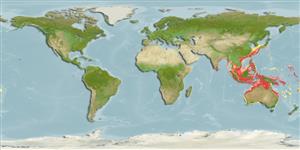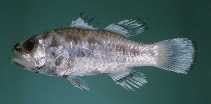Jaydia poeciloptera (Cuvier, 1828)
Pearly-finned cardinalfish
Beobachtung melden im Fish Watcher
| Native range | All suitable habitat | Point map | Year 2050 |

|
| This map was computer-generated and has not yet been reviewed. |
| Jaydia poeciloptera AquaMaps Data sources: GBIF OBIS |
Hochladen Photos und videos
Pictures | Google BildJaydia poeciloptera
Picture by Randall, J.E.
Pictures | Google BildJaydia poeciloptera
Picture by Randall, J.E.
Klassifizierung / Names Namen | Synonyme | Catalog of Fishes(Gattung, Arten) | ITIS | CoL | WoRMS | Cloffa
> Kurtiformes (Nurseryfishes, cardinalfishes.) > Apogonidae (Cardinalfishes) > Apogoninae
More on author: Cuvier.
More on author: Cuvier.
Environment: milieu / climate zone / depth range / distribution range Ökologie
seewasser; brackwasser demersal; tiefenbereich 19 - 146 m (Ref. 57178). Tropical
Verbreitung Länder | FAO Gebiete | Ecosystems | Vorkommen | Point map | Einführungen | Faunafri
Indo-Pacific: as far north as Japan, southward to the Arafura Sea (Ref. 9819) and north Australia and westward to Madras, India.
Size / Gewicht / Alter
Nocturnal species. Occurs inshore over soft bottom (Ref. 7300). Lives in holes in the mud during the day. Usually trawled near river mouths (Ref. 48635).
Life cycle and mating behavior Geschlechtsreife | Fortpflanzung | Ablaichen | Eier | Fecundity | Larven
Hauptreferenz
Upload your references | Referenzen | Koordinator | Partner
Weber, M. and L.F. de Beaufort, 1929. The fishes of the Indo-Australian Archipelago. V. Anacanthini, Allotriognathi, Heterostomata, Berycomorphi, Percomorphi: Kuhliidae, Apogonidae, Plesiopidae, Pseudoplesiopidae, Priacanthidae, Centropomidae. Leiden (The Netherlands): E.J. Brill, 5:xiv, 458 p. (Ref. 4900)
IUCN Rote Liste Status (Ref. 130435: Version 2024-2)
nicht bedroht (LC) ; Date assessed: 14 August 2023
CITES
Not Evaluated
Bedrohung für Menschen
Harmless
Nutzung durch Menschen
FAO - Publication: search | FishSource |
Mehr Information
Trophic ecology
Nahrungsorganismen
Nahrungszusammensetzung
Nahrungsaufnahme
Food rations
Räuber
Nahrungsorganismen
Nahrungszusammensetzung
Nahrungsaufnahme
Food rations
Räuber
Population dynamics
Growth parameters
Max. ages / sizes
Length-weight rel.
Length-length rel.
Längenhäufigkeiten
Mass conversion
Rekrutierung
Dichte
Growth parameters
Max. ages / sizes
Length-weight rel.
Length-length rel.
Längenhäufigkeiten
Mass conversion
Rekrutierung
Dichte
Life cycle
Fortpflanzung
Geschlechtsreife
Maturity/Gills rel.
Fecundity
Ablaichen
Spawning aggregations
Eier
Eientwicklung
Larven
Larven Pop.Dyn.
Fortpflanzung
Geschlechtsreife
Maturity/Gills rel.
Fecundity
Ablaichen
Spawning aggregations
Eier
Eientwicklung
Larven
Larven Pop.Dyn.
Anatomy
Kiemenoberfläche
Brain
Otolith
Kiemenoberfläche
Brain
Otolith
Physiology
Body composition
Nutrients
Oxygen consumption
Swimming type
Swimming speed
Visual pigments
Fish sound
Diseases & Parasites
Toxicity (LC50s)
Body composition
Nutrients
Oxygen consumption
Swimming type
Swimming speed
Visual pigments
Fish sound
Diseases & Parasites
Toxicity (LC50s)
Genetics
Genetik
Heterozygosity
Vererbbarkeit
Genetik
Heterozygosity
Vererbbarkeit
Human related
Aquaculture systems
Aquakultur Profile
Zuchtlinien
Ciguatera cases
Stamps, coins, misc.
Aquaculture systems
Aquakultur Profile
Zuchtlinien
Ciguatera cases
Stamps, coins, misc.
Tools
E-book | Feldführer | Längenhäufigkeits Tool | Lebensdaten Tool | Punkt Karte | Classification Tree
| Catch-MSY |
Zusatzinformationen
Download XML
Zusammenfassung | Point data | Namen | Photos
Internet Quellen
AFORO (otoliths) | Aquatic Commons | BHL | Cloffa | BOLDSystems | Websites from users | FishWatcher Einträge suchen | CISTI | Catalog of Fishes: Gattung, Arten | DiscoverLife | ECOTOX | FAO - Publication: search | Faunafri | Fishipedia | Fishtrace | GenBank: Genom, nucleotide | GloBI | Google Books | Google Scholar | Google | IGFA World Record | MitoFish | Otolith Atlas of Taiwan Fishes | PubMed | Reef Life Survey | Socotra Atlas | Tree of Life | Wikipedia: Gehe zu, Suchen | World Records Freshwater Fishing | Zoological Record
Estimates based on models
Preferred temperature (Ref. 123201): 23.4 - 28.5, mean 27.3 °C (based on 836 cells).
Phylogenetic diversity index (Ref. 82804): PD50 = 0.5000 [Uniqueness, from 0.5 = low to 2.0 = high].
Bayesian length-weight: a=0.00977 (0.00416 - 0.02293), b=3.09 (2.91 - 3.27), in cm total length, based on LWR estimates for this Genus-body shape (Ref. 93245).
Trophic level (Ref. 69278): 3.6 ±0.6 se; based on size and trophs of closest relatives
Widerstandsfähigkeit (Ref. 120179): hoch, Verdopplung der Population dauert weniger als 15 Monate. (Preliminary K or Fecundity.).
Fishing Vulnerability (Ref. 59153): Low vulnerability (10 of 100).




